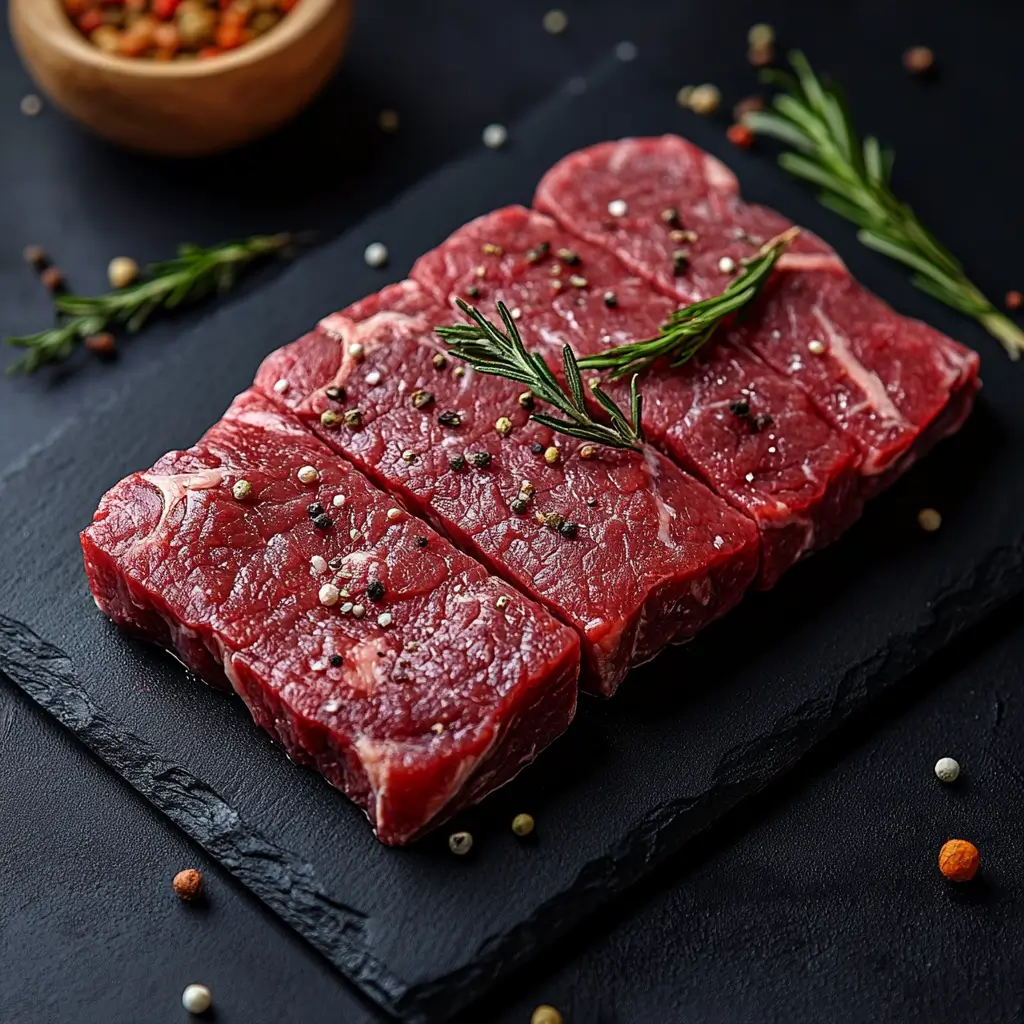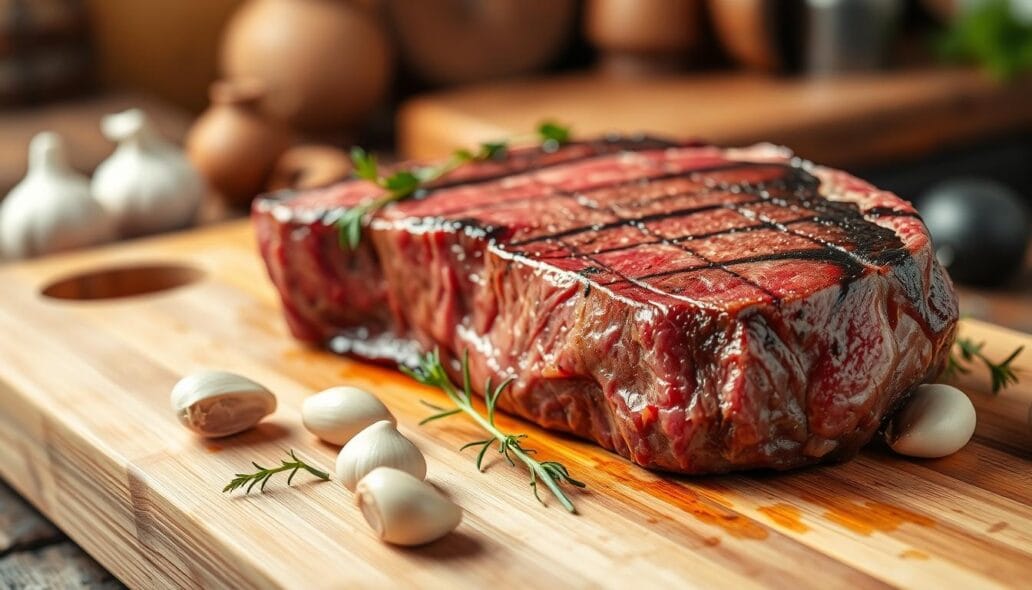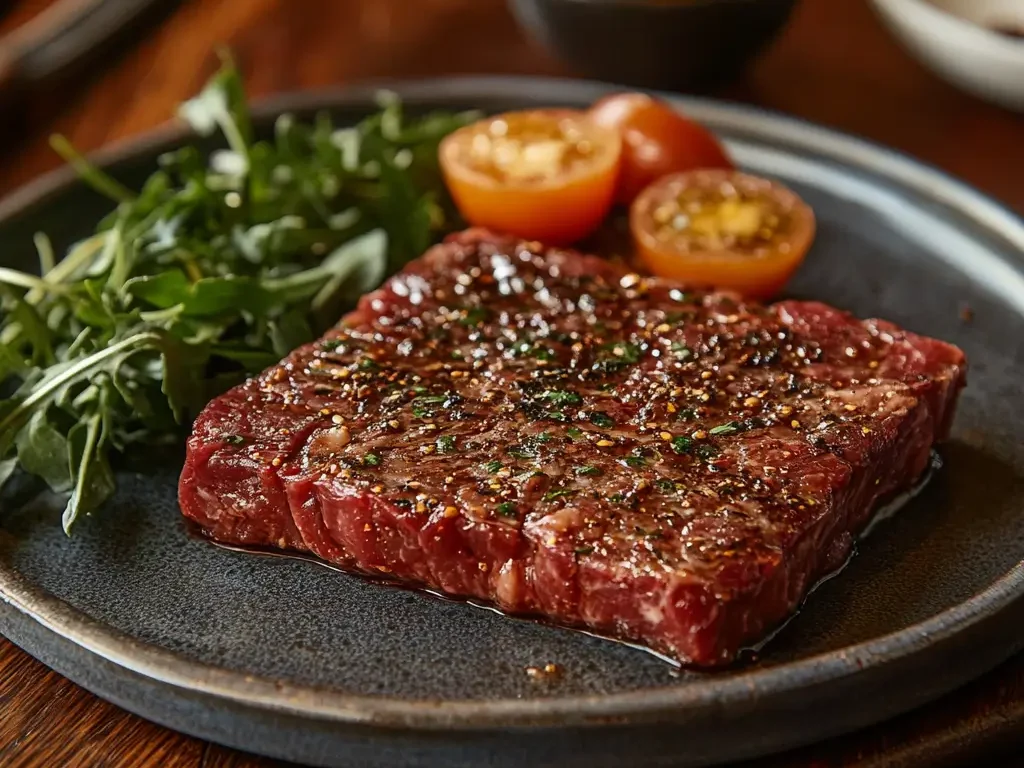The beef lion flat iron steak label tells you about the steak’s quality, where it comes from, and its nutrition. This helps you pick a top-notch steak that fits your cooking needs and tastes. With so many beef products out there, learning to read labels can make your meals better.
The beef lion flat iron steak comes from the chuck area. This region gives us cuts like chuck short ribs and flat-iron steak. The beef grading system is important for knowing the steak’s quality. Prime cuts are the best, and knowing this helps you choose well.
The beef lion flat iron steak label is more than a tag. It’s a guide to the meat’s quality and where it comes from. It gives you important details about the cut, grade, and source. This ensures you get a steak that’s just right for you, whether you want something lean or rich.
Table of Contents
Understanding the Beef Lion Flat Iron Steak Label
The beef lion flat iron steak label tells you a lot about the steak. It shows the steak’s quality and where it comes from. Knowing the beef grading system and meat labeling regulations is key. The USDA label tells you if the beef is USDA Choice or Prime. This is important because it affects how tender and tasty the steak is.
When you look at the label, you’ll see important details. Here are a few things to check:
- Grade: USDA Prime or Choice
- Packaging date and lot number
- Handling and storage instructions
Knowing these details helps you understand beef labels better. It lets you choose a high-quality steak. By learning about label terms and meat labeling regulations, you can make better choices when buying beef.

It’s also important to know about the beef grading system. This system checks the steak’s marbling, tenderness, and flavor. It gives a full picture of the steak’s quality. With this knowledge and understanding of the label, you can confidently pick the best steak for you.
| Label Element | Description |
|---|---|
| Grade | USDA Prime or Choice |
| Packaging Date | Date the steak was packaged |
| Lot Number | Unique identifier for the steak |
Origins and Characteristics of Flat Iron Steak
Flat iron steak comes from the shoulder area. It’s known for being tender and flavorful. This cut is special because it’s carefully trimmed to remove tough parts, making it juicy and tasty.
It’s a great choice for any meal, especially for grilling. Whether you’re a pro in the kitchen or just like to grill, flat iron steak is perfect. It’s the best beef for grilling for any occasion.
The beef lion flat iron steak has a unique flavor. It’s versatile and can be cooked in many ways. You can grill, pan-sear, roast, or sous vide it. For more ideas, check out crazerecipe.com.
Some key characteristics of flat iron steak include:
- Rich flavor profile
- Tender texture
- Versatility in cooking methods
- High quality standards, such as “USDA Choice” and “100% grass-fed”

When cooking flat iron steak, remember it has 200 calories, 9g of fat, and 30g of protein per serving. It’s a healthy choice and tastes amazing. It’s perfect for any meal, whether you want something healthy or a tasty best beef for grilling experience.
| Nutrient | Amount per serving | % Daily Value |
|---|---|---|
| Calories | 200 | |
| Total Fat | 9g | |
| Saturated Fat | 3.5g | |
| Protein | 30g | |
| Cholesterol | 23% | |
| Iron | 17% | |
| Zinc | 33% |
Quality Indicators on Your Beef Label
When you’re looking for the best cuts of beef, it’s key to know what the labels mean. The USDA grades like Prime or Choice show how tender and tasty the steak is. These labels help you pick a steak that fits your cooking dreams.
A beef cuts chart is a great guide. It shows you the different cuts of beef, like the flat iron steak, and what makes them special.
USDA Grade Classifications
The USDA grades are about marbling, maturity, and muscle. These things make a steak tender, flavorful, and high-quality. For instance, a Prime grade steak has more marbling, making it even more tender and tasty.
Organic and Natural Certifications
Organic and natural labels mean the steak is made under strict rules. They ensure the steak is without artificial stuff and hormones. Cooking a flat iron steak right is crucial to enjoy its full flavor and tenderness.
Here is a table summarizing the quality indicators on a beef label:
| Quality Indicator | Description |
|---|---|
| USDA Grade Classification | Indicates the steak’s quality and tenderness |
| Organic Certification | Ensures the steak meets strict standards for production methods and ingredients |
| Natural Certification | Ensures the steak is free from artificial additives and hormones |

Nutritional Information and Health Benefits
Understanding beef labels is key, especially for the beef lion flat iron steak. It’s packed with protein, iron, and B vitamins. This makes it a great choice for a healthy diet. With about 149 calories per 100-gram serving, it’s also a lean protein option.
A 100-gram serving of beef lion flat iron steak has 6.4 grams of total fat. It also has 2.6 grams of saturated fat and 58 milligrams of cholesterol. It’s a good source of phosphorus and selenium, with 206 milligrams and 21.3 micrograms per 100-gram serving, respectively. It has only 45 milligrams of sodium per 100-gram serving, which is less than the American Heart Association’s daily limit.

- High-quality protein for muscle growth and maintenance
- Rich in iron for healthy red blood cells
- Good source of B vitamins for energy metabolism
- Low in sodium for heart health
By knowing the nutritional info and health benefits of the beef lion flat iron steak label, consumers can make better choices. They can enjoy a delicious and healthy meal.Selecting the Perfect Flat Iron Steak
Choosing a flat iron steak involves several factors. Knowing meat labeling regulations helps you make a smart choice. The beef cuts chart is key to understanding different beef cuts and their traits.
A flat iron steak recipe can enhance this cut’s flavor. But, picking a high-quality steak is crucial. Look for marbling and color to gauge quality. Marbling affects the steak’s tenderness and taste.
Here are some key considerations when selecting a flat iron steak:
- Weight and portion guidelines: Choose a steak that meets your culinary needs and budget.
- Price point considerations: Flat iron steaks can vary in price, depending on factors like quality and source.
- Visual indicators of quality: Marbling, color, and overall appearance can indicate the steak’s tenderness and flavor.
By considering these factors and understanding the beef cuts chart and meat labeling regulations, you can pick the perfect flat iron steak. Enjoy a delicious flat iron steak recipe.
| Steak Cut | Marbling | Tenderness |
|---|---|---|
| Flat Iron | Rich | High |
| New York Strip | Moderate | High |
Proper Storage and Handling Guidelines
Keeping beef lion flat iron steak fresh and quality is key. Knowing beef labels helps you choose well. Store it in a cool, dry spot and handle it carefully to avoid damage.
Keeping the right temperature is crucial. Store beef lion flat iron steak in the fridge at under 40°F (4°C). Also, use airtight containers to keep moisture and contaminants out.
Here are some tips for handling and storing beef lion flat iron steak:
- Store in a cool, dry place
- Handle gently to prevent damage
- Use airtight containers to prevent moisture and contamination
- Keep refrigerated at a temperature below 40°F (4°C)
By following these tips, your beef lion flat iron steak will stay fresh and tasty longer. Always check the beef lion flat iron steak label for specific storage and handling advice.
| Storage Method | Temperature | Shelf Life |
|---|---|---|
| Refrigeration | Below 40°F (4°C) | Up to 3 days |
| Freezing | 0°F (-18°C) or below | Up to 6 months |
Preparation Methods for Flat Iron Steak
Preparing a delicious flat iron steak involves several steps. Marinating techniques are key to enhancing flavor and tenderness. Use a mix of olive oil, garlic, and herbs for 2 to 8 hours.
Temperature is also crucial. Cook to 130°F to 135°F for a perfect medium-rare. For grilling, cook on medium-high heat for 20 to 25 minutes. For exact control, try sous vide cooking for 2 to 4 hours.
Resting the steak for 5 to 10 minutes before slicing is important. This allows the meat to reabsorb its juices. This tip works well for a simple flat iron steak recipe grilled to your liking. Flat iron steak is the best beef for grilling due to its tenderness and flavor.
By following these methods and tips, you can make a delicious and memorable flat iron steak. These techniques are great for both seasoned chefs and beginners.
Common Misconceptions About Beef Labels
Many people get confused by marketing terms on beef labels. It’s key to know the difference between marketing and regulated terms. For example, a beef lion flat iron steak label shows what’s important. This knowledge helps you pick the right steak for your meals.
Some think “premium” means it’s regulated, but it’s just marketing. Knowing what’s on a meat label helps you choose based on taste, budget, and values. For instance, a good flat iron steak looks bright red and is fresh.
Learning about beef labels helps you pick the right steak. Look at the weight, price, and packaging. These tell you about freshness and when to eat it.
Marketing Terms vs. Regulated Terms
It’s important to know the difference between marketing and regulated terms on labels. Regulated terms are strict and enforced. Marketing terms aim to sell the product. Knowing this helps you make better choices and avoid false claims.
Understanding “Premium” Claims
“Premium” claims are often used to sell a product, but they’re not always regulated. To make smart choices, look for regulated terms. This way, you can find a steak that fits your needs and avoid being tricked by marketing.
Sustainable and Ethical Labeling Practices
When buying prime cuts of beef, people now care about where it comes from. The beef grading system can be hard to understand. But, look for labels like “sustainably sourced” or “humanely raised.” This ensures the beef is tasty, good for the planet, and fair to workers.
When choosing best beef for grilling, think about animal care, environmental impact, and fair work. Opting for sustainably labeled beef supports farmers who care about animals and the earth.
Here are some benefits of sustainable and ethical labeling practices:
- Improved animal welfare
- Reduced environmental impact
- Increased transparency in the supply chain
- Support for fair labor practices
As more people value sustainable and ethical labeling, demand for prime cuts of beef is growing. By choosing wisely, you help the beef industry improve. You also support farmers and ranchers who care about the planet and people.
| Label | Description |
|---|---|
| Sustainably Sourced | Beef that is sourced from farms that prioritize environmental sustainability and animal welfare |
| Humanely Raised | Beef that is raised with a focus on animal welfare and humane treatment |
| Grass-Fed | Beef that is raised on a diet of grass, allowing the animals to roam and graze freely |
FAQ
What does the beef lion flat iron steak label tell me about the quality and origin of my meat?
The label on your beef lion flat iron steak tells you a lot. It shows the cut, grade, and where it came from. This ensures you get a high-quality steak that meets your cooking needs.
What do the terms “prime” and “choice” on the beef label mean?
“Prime” and “choice” on the label mean the steak is tender and flavorful. This is key to knowing the meat’s quality.
What is flat iron steak, and why is it a prized cut of beef?
Flat iron steak is known for its rich taste and tender texture. It comes from the shoulder area and is carefully trimmed to remove tough parts.
What are the quality indicators I should look for on the beef label?
Look for USDA grades and organic or natural labels on the beef label. These show the steak’s quality and if it’s genuine.
What are the health benefits of consuming beef lion flat iron steak?
Beef lion flat iron steak is good for you. It’s full of protein, iron, and B vitamins. It’s a great choice for a healthy diet.
How do I select the perfect flat iron steak?
To pick the best flat iron steak, look at its marbling and color. Also, consider its weight, portion, and price.
How should I store and handle beef lion flat iron steak to maintain its quality and freshness?
Keep the steak cool and dry to keep it fresh. Handle it gently to preserve its quality.
What are the best preparation methods for cooking flat iron steak?
For a delicious flat iron steak, use good marinades and follow temperature guidelines. Let it rest and serve it right to get it just right.
What are some common misconceptions about beef labels?
It’s important to know the difference between marketing terms and real labels. This helps you make smart choices at the meat counter and avoid false “premium” claims.
Why are sustainable and ethical labeling practices important for the beef industry?
Choosing “sustainably sourced” or “humanely raised” steaks supports farmers who care about animals and the environment. It helps make the beef industry better for the future.
Conclusion: Making Informed Decisions About Your Beef Purchase
Choosing the right beef lion flat iron steak is key for a great meal. Knowing how to read beef labels helps you pick a steak that’s just right. Whether you’re a pro chef or a backyard grill master, making smart choices is crucial.
The USDA grading system and other labels help you find a top-notch flat iron steak. Look for marbling, weight, and price to get a steak that’s tender, flavorful, and healthy. This way, you can enjoy a meal that’s both delicious and affordable.
By learning about beef labels and cooking techniques, you’ll get better at cooking flat iron steak. Start making informed choices and enjoy the tasty results that follow.
